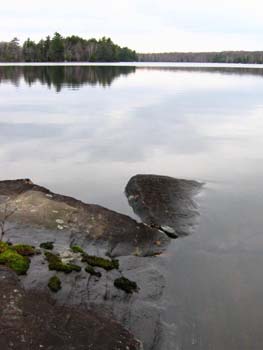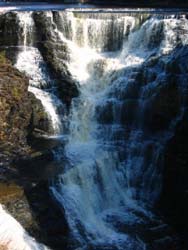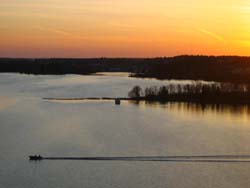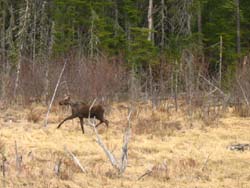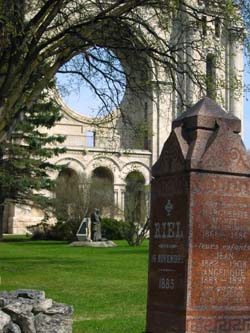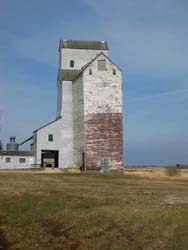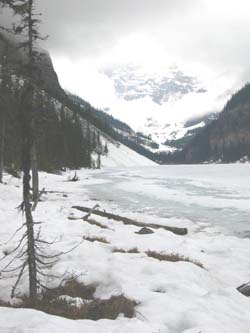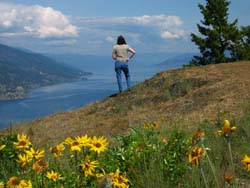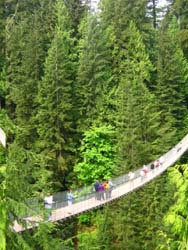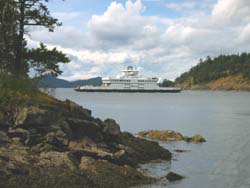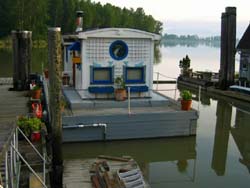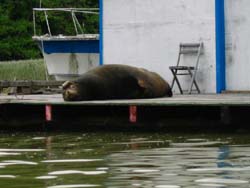|
|
A
Cross Canada Odyssey We backed the car out of the driveway and began a 5,500-kilometre odyssey that would wind from Niagara through five provinces to our new home in the Gulf Islands of British Columbia. For the next 15 days we would live in a kaleidoscope with every turn of the car wheel bringing forth phenomenal landscapes, wildlife and experiences as though we were in an IMAX movie with a documentary of Canada being played on our windscreen. Niagara, with its vineyards and orchards tinged in emerald green from spring buds, bade us farewell. The cliffs and woods of the Niagara Escarpment, along which we had so often hiked, looked down in brooding silence. |
||||
Evening near Bala,
Ontario |
The mighty Kakabeka Falls near Thunder Bay, Ontario
The sun sets over the Lake of the Woods near Kenora, Ontario
A moose calf along the north shore of Lake Superior
Louis Riel's grave in St. Boniface, Winnipeg, Manitoba
Grain elevator in Saskatchewan
Lake Louise Alberta under snow and cloud
Sunny Okanagan Valley, British Columbia
Vancouver's Thrilling Capilano Suspension Bridge
A British Columbia Ferry in the Gulf Islands (our new home)
Our houseboat Waterlily
A sea lion dozing on a fisherman's dock
|
||||
We fought through the ever-congested,
sprawling Toronto area and into Muskoka's cottage country dotted with
thousands of lakes. Under a light rain the
Trans-Canada Highway shimmered like a silver
thread as it rolled around gentle curves and rose and fell with the
topography. At Midland, the gateway to Georgian Bay and its complex
of islands, we hiked into Wye
Marsh, a wetland rich with bird life.
A falconer, his wrist covered by a thick leather glove, carried a
young Harris Hawk with razor-sharp talons That evening the sun set over the edge of a quiet lake deep in the forest accompanied by the haunting call of a loon. In the morning we explored Cranberry Marsh near Bala and learned how the little red berries are harvested by boat. Then the silver thread led north to Sudbury, with Inco's 381-metre superstack visible from afar. At the Discovery Centre, displays showed how a giant meteor impact created the unusual geology and mineral wealth of the Sudbury basin. We donned miners' hats and descended down the dark shaft of Big Nickel Mine. Following dripping, rock-bolted tunnels called drifts, we witnessed how miners extract the ore that has made this city the nickel capital of the world. North of Sault Ste. Marie, the landscape turned desolate, wild and hilly. We followed the northern shore of Lake Superior, which stretched to the horizon like an ocean, as waves crashed onto boulder strewn coves. A light snow draped evergreens with white coats, but turned into nasty flying spray whenever a logging truck roared past. Fractured road cuts were often adorned with cairns, inukshuks and, of course, graffiti. Frequent road signs warned of moose, and finally we saw a spindle-legged moose with her calf trudging through a marsh. The 700 kilometres we drove to reach Thunder Bay that day, a mere fraction of Ontario, would have crossed several countries in Europe. Just past Thunder Bay are the foaming waters of Kakabeka Falls. These falls "surpass even those of Niagara in picturesque beauty," wrote artist Paul Kane in 1854. As we hiked the portage trail around the falls, the primary route into the interior in the early 1800s, we could only wonder at the hardships suffered by early explorers compared to our comfortable journey. The stretch to Dryden is the most desolate of the entire Trans Canada highway. Long distances with no other cars in view were punctuated by brief periods of frustration as we queued up behind a slow car or truck waiting for a passing lane. Lonely towns were marked by hand-painted billboards extolling ice fishing and snowmobiling; their gas stations charged high prices and sold live bait. In Kenora, located on the Lake of the Woods, a watery paradise of 2000 islands, the boat rules and many shops have docks for their boating customers. That evening a flaming orange and pink sun set over still waters marked only by the vee of a fisherman heading home with his catch. Entering Manitoba was like landing on another planet. The rolling landscape of forest, lakes and rocky outcrops was replaced by billiard-table flat farmland with lonely clumps of trees forming windbreaks for homesteads. The road reached to the far horizon. Soon we were in Winnipeg
and with ice-cream in hand exploring the Forks, a Oak Hammock Marsh, just north of Winnipeg, was marked by the constant cacophony of bird calls, for this is a major migratory stopping place for an amazing variety of ducks, geese and songbirds. With binoculars in hand we wandered in the marshes and quickly agreed with British Airways opinion that this is the top birding place in the world. As we gazed at a bear den and its adjacent scratching tree, whose bark was in shreds to a height of 3-metres, we were glad we had detoured north to Riding Mountain National Park. We saw numerous deer, beaver lodges, elk and even hulking bison. Evidence of moose was everywhere: fresh tracks, droppings and bleached bones where this mighty creature had been felled, likely by wolves. Next day a ruler-straight silver thread carried us westward under an enormous unpolluted sky into the vast prairie land of Saskatchewan. We wandered south of the TransCanada into a quiltwork of gigantic farms and peaceful farming villages to seek a tiny cemetary where my wife's grandparents are buried. At the midpoint of Canada, we were also half way through our journey. Driving along the Red Coat Trail in southern Saskatchewan, the midway point in our journey from Niagara to the Gulf Islands, couldn't have been simpler. The road was like a ruler line on a billiard table and rarely did we see another car. At Ceylon, a tiny outpost of perhaps 200 people, we found the cemetery where my wife's grandparents rest. The tombstones stand alone, dark markers against an expanse of fields. We continued through a vast quiltwork of farmland, the flatness broken only by a lonely town, a towering grain elevator or a homestead surrounded by a windbreak of trees. We discovered that the Prairies have a powerful appeal. The sky is enormous and the air fresh, crisp and delectable. In southwest Saskatchewan the flat landscape began to undulate and near Eastdale we entered badlands. We visited the T.rex Discovery Centre, an attractive building set into the side of a hill, with excellent displays of hulking tyrannosauruses, including Scotty, whose bones were discovered nearby. Nearing the Alberta border the road climbed in elevation and led us to Cypress Hills Interprovincial Park, an incongruous island of high land-higher than any point in Ontario or Quebec-in the middle of the flat prairies and cloaked with a forest of lodgepole pines. Next morning we rejoined the Trans Canada highway and soon were in the prairies of Alberta with numerous oil facilities dotting the landscape. Our first stop was the world-class Tyrell Museum in Drumheller, set in the fossil-rich badlands. The Burgess Shale display showed an ancient reef alive with ancient organisms, and we strolled amongst dinosaurs of every size and shape. That evening we sampled "cowboy cuisine" at Buzzards Restaurant in Calgary, including the infamous prairie oysters. We also visited the Alberta Boot Company where the manager drawled and sauntered like a cowboy as he showed how boots are custom-made from ostrich, kangaroo, crocodile and cowhide. Continuing westward to Banff we watched the prairies transform, almost miraculously, into towering mountains. Now we were surrounded by massive crags adorned with snow, rushing streams, lakes with beaver dams and hiking trails leading tantalizingly into deep forests. A guide led us around Johnson Lake and explained mosses, trees, animals and local history. We saw an eagle, an osprey nest, a herd of elk, several deer and even a coyote. We spent the night in an eagle's aerie, the romantic Storm Mountain Lodge at 1750 metres elevation. The wild peaks soared high around us, afire with the golden rays of the setting sun. Next day we continued to Lake Louise to find it still frozen. Japanese tourists swarmed about taking non-stop photos and then crowding into a huddle to look at the results. At Yoho Pass we had a great sighting: a large black bear and her two cubs ambling into the forest. We passed the spiral railway tunnels, Emerald Lake and then zig-zagged into the valley carved by the Kicking Horse River. A cyclist with fully-loaded panniers laboured up the steep slope. The road climbed to Rogers Pass where we hurried through the avalanche-protection sheds fearful of the steep snow banks high above. Finally, we descended to the warmer inter-range area with leaves on the trees and lilacs in full bloom. Turning south into the Okanagan Valley, we were greeted by a long azure lake trapped between two verdant mountain ranges. In glorious warmth and no humidity, we wandered through Kelowna's waterfront, laced with parks, fountains and marinas. Then we hiked at Myra Canyon, where the historic trestle bridges that were destroyed in the forest fires of 2003 are being rebuilt. Hearing the call of Bacchus, we followed winding back roads past small horse farms to explore the numerous lakeside wineries. At Summerhill Winery we entered a replica of Egypt's Great Pyramid, where Earth's energy is focussed into their wines. Inside it was cool, serene and felt sacred. On the patio of their Sunset Bistro we enjoyed west-coast fare while watching the sky and hills transform into flaming vermilions and oranges. We awoke to another hot day and drove south with the sun sparkling on Okanagan Lake, misty hills rising on both sides and vineyards arrayed on the slopes. Soon we turned west and followed a river valley with gentle, green mountains looming on each side. With the volume of traffic escalating we struggled to Ladner, a southern suburb of Vancouver, where we landed in heaven: the River Run Cottages on the Fraser River. We spent the night in the houseboat, Waterlily, where we rose and fell with the tides and whenever a boat passed, we rocked gently in the wake. I kayaked to the fishing-boat harbour. Suddenly, a ferocious roar split the air. On the dock only metres away was a huge, blubbery sea lion, upset that I was interrupting his siesta. A large wake trailed behind as I raced away. Next morning a white swan cruised by, elegantly mirrored in the still waters. We visited Capilano Suspension Bridge, swaying back and forth over a dizzying canyon. A suspended walkway let us explore the enormous 200-year-old Douglas Firs high amongst their branches. Then on to Stanley Park in Vancouver, alive with flowers, where we joined strollers and in-line skaters along the Sea Wall walk, where harbour and ocean views abound around each curve. Next morning we drove aboard the Queen of Nanaimo and sailed southwest The sun sparkled as we entered an archipelago of picturesque islands cloaked in dark green. We watched a passing superferry make sharp turns as it manouvered through a narrow pass. Soon we arrived at Pender Island where sailboats skimmed along the water like butterflies of the sea. As we rolled off the ferry one journey ended; but another was about
to begin. |
|||||
Hans recommends If you plan to drive across Canada, which I highly recommend, my
single most important tip is to take extra time. It's a huge country
with an endless smorgasbord of exciting things to do and see, so allow
ample time to relax and enjoy it. A quick visit to each province's
tourism website (see below for a list) before you leave will yield
tons of useful information on accommodations, events and sights. You
can also order the official provincial road maps at no charge. A membership
in CAA
or AAA
is a good investment for not only do they provide excellent maps and
guidebooks, but you will get discounts at most motels and some attractions
and restaurants. And, obvious as it is, don't be shy about getting
off the TransCanada and taking smaller roads to smaller places. You
will love them. Recommended websites: Big Nickel Mine, Sudbury: www.dynamicearth.ca Accommodation Sault Ste Marie: Best Western, 705 942-2500 www.vcmbc.com (Vancouver, Coast and Mountains region) Accommodation www.coasthotels.com/home/sites/kelowna Activities www.whitemountainadventures.com Dining ©Text and photographs copyright Hans Tammemagi 2005
|
|||||
